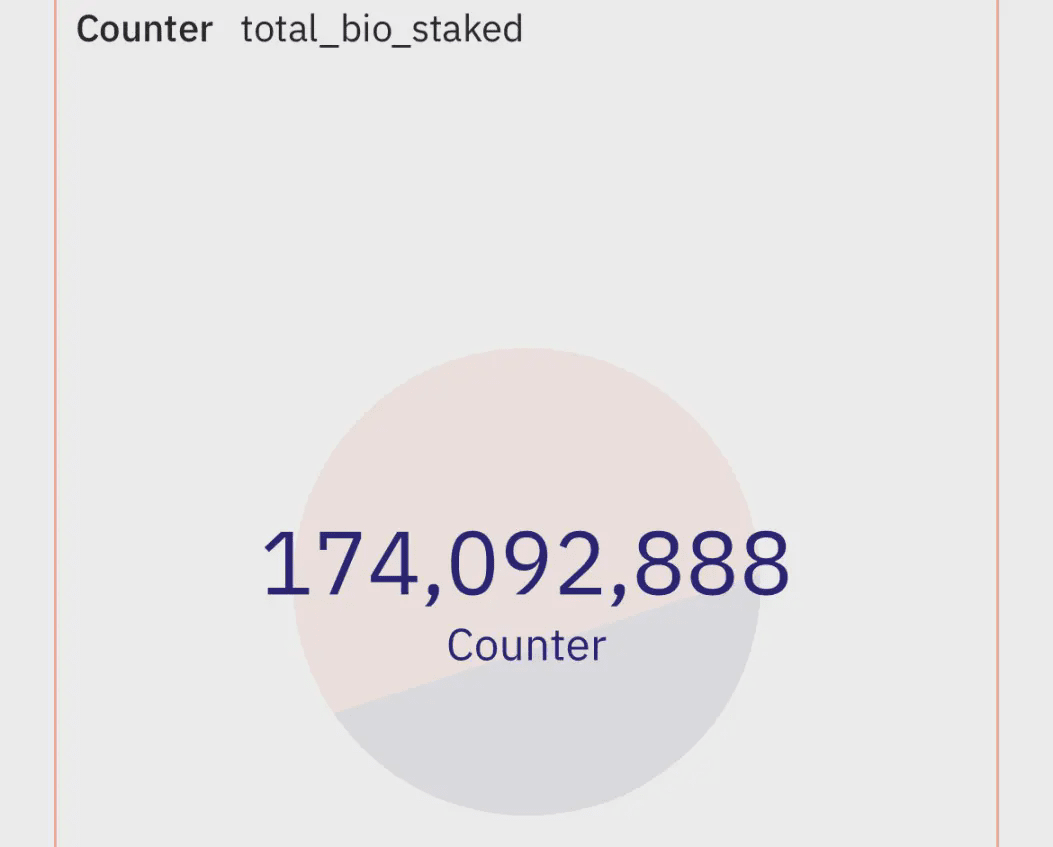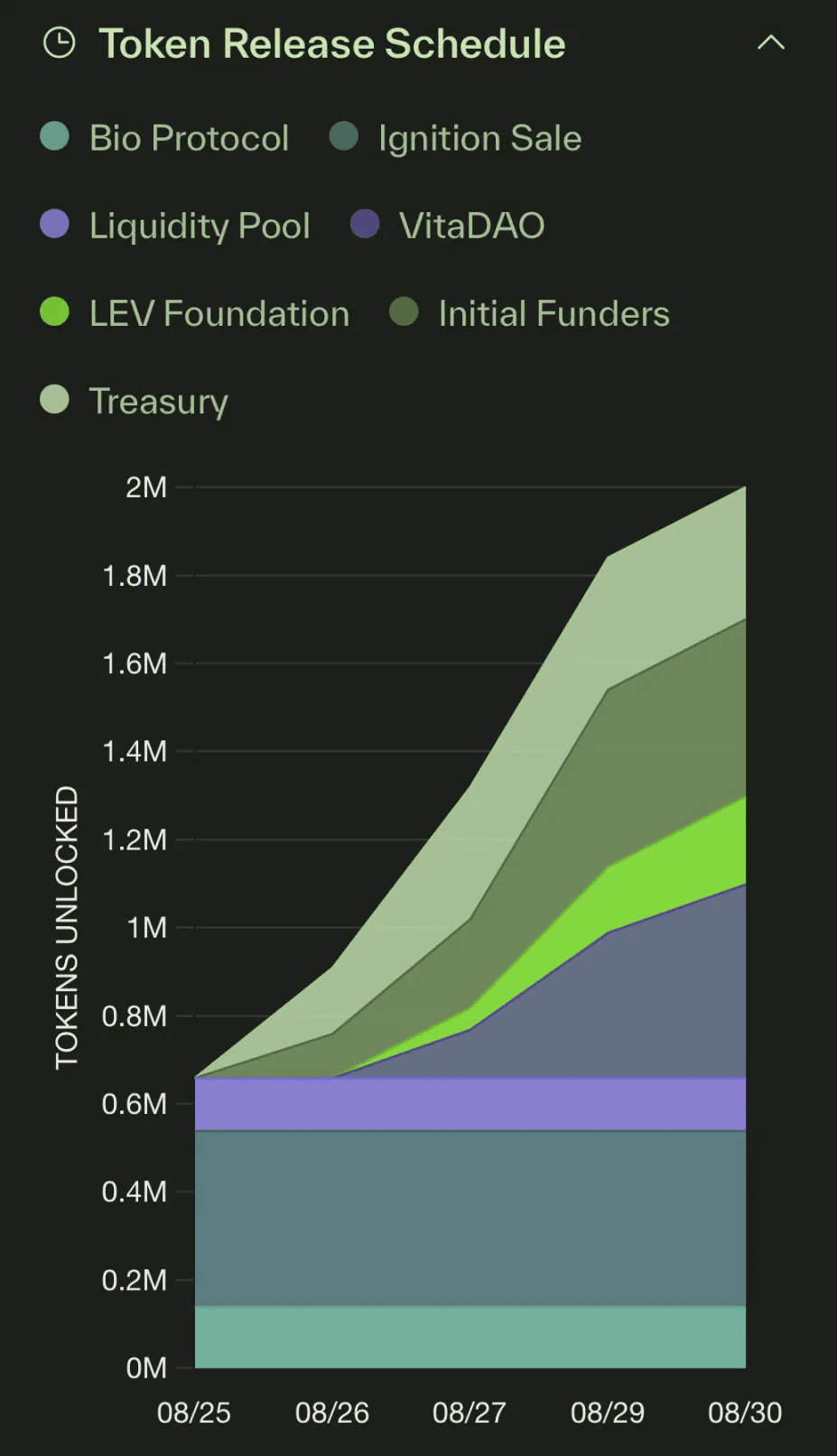Author: Nicky, Foresight News
The token BIO of Bio Protocol has recently performed remarkably. According to Bitget data, the price of BIO started at $0.056 on August 6, 2025, and climbed to a peak of $0.2081 on August 22, with an increase of over 270% during this period.

Currently, the staking scale of BIO has reached approximately 174 million tokens, accounting for about 9.3% of the total circulating supply of 1.855 billion tokens. Meanwhile, BIO has been listed on several mainstream exchanges, including Binance, Coinbase, and Bithumb.
The DeSci boom at the end of 2024 lasted only a few months. After BIO landed on Binance, its token performance can be described as 'disastrous', having reached a historical high of $0.8 after its launch but then declining until August 2025, when the token price hovered around $0.05, having dropped over 90% from its historical high. So what exactly revived BIO?
Tracing back to the project's origin, on November 8, 2024, Binance Labs (now YZi Labs) announced an investment in Bio Protocol. Although the investment details were not disclosed, this move marked mainstream capital's recognition of the DeSci track.
As a representative project in the DeSci track, the core goal of Bio Protocol is to 'transform the funding and commercialization model of early biotech research' and build a network of biotechnology DAOs.
By utilizing blockchain technology, global scientists, patients, and investors can jointly participate in new drug development, addressing the pain points of traditional research where 'funding is concentrated in large pharmaceutical companies and results are closed off.' This helps global participants fund and co-participate in new drug development, especially concerning rare diseases, longevity research, and emerging health issues.
On June 3, 2025, the token PYTHIA of the DeSci project started rising, increasing from $0.0168 to $0.122 on August 14, with a rise of 626%.
On July 31, 2025, Coinbase simultaneously launched the tokens BIO and RSC for two DeSci projects, marking the return of DeSci to the view of the mainstream digital currency market in the West.
Since then, the token VITA of the DeSci project VitaDAO has continued to rise from $1.17 on August 1 to a peak of $2.22 on August 22, with a total increase of 89%. The token NEURON of Cerebrum DAO also performed well in August, with a rise of over 180% this month. Meanwhile, the token CRYO of CryoDAO saw an increase of over 200% this month, and the token GROW of ValleyDAO increased by 76%, while the token HAIR of HairDAO increased by 67.5% this month. This shows that DeSci is reviving.
Aubrai: How AI Scientists Are Rewriting the Rules of Longevity Research?
Entering 2025, Bio Protocol accelerated iteration. On August 21, Bio Protocol and VitaDAO launched the first BioAgent Launch project, Aubrai, marking the official implementation of its 'decentralized research agency' plan. This sale lasted only 24 hours, allowing users to participate by staking BioXP and investing in BIO tokens, with the TGE of the token AUBRAI scheduled for August 25.

Currently, the token economics of AUBRAI has been announced, with a total supply of 2 million tokens. The token distribution is as follows: 20% for sales, 6% for liquidity pools, 15% for treasury, 20.1% allocated to initial funders, 10% for the LEV Foundation, 22% for VitaDAO, and 6.9% for Bio Protocol.
Aubrai originates from the private laboratory data of longevity research pioneer Dr. Aubrey de Grey, who proposed the 'Strategies for Engineered Negligible Senescence' (SENS) aimed at preventing age-related diseases by repairing damage to aging human cells. He holds a bachelor's degree in computer science and a Ph.D. in biology from Cambridge University and has authored works such as (Mitochondrial Free Radical Theory of Aging) (1999) and (Ending Aging) (2007).
de Grey is currently the chairman and chief scientific officer of the LEV Foundation. The foundation focuses on longevity research, and its flagship project 'Robust Mouse Rejuvenation' tests late-stage intervention therapy combinations through large-scale mouse lifespan experiments. These experiments, in collaboration with Ichor Life Sciences, emphasize damage repair methods and avoid early interventions like genetic modification to accelerate clinical translation to humans.
Another LEV project 'Transplants on Demand' explores tissue engineering, funding Keinice Bio's low-temperature preservation technology, which uses super-cooled helium to achieve organ vitrification preservation. This avoids the toxicity issues of traditional cryoprotectants and aims to provide 'ready-to-use' young organ replacements to address organ failure caused by aging.
The LEV Foundation also supports the Alliance for Longevity Initiatives, a 501(c)(4) non-profit organization aimed at promoting U.S. government policy support for longevity research. By collaborating with relevant experts, it seeks to enhance public awareness of aging-related chronic diseases and secure national-level funding.
Through these studies, his private laboratory has accumulated thousands of unpublished research notes, internal experimental data, and collective knowledge in the global longevity field. These 'private research assets', which were once limited to the core team, are now integrated by Aubrai as training data.
In practical applications, Aubrai has transformed the workflow of the de Grey team. It manages more than a dozen complex longevity studies, compressing what originally took weeks of manual review into just days. It also identifies dosage conflicts, timing mismatches, and hidden biases, even discovering new issues that the team had not noticed.
According to the official roadmap, Aubrai has currently received joint funding from Bio Protocol and VitaDAO for the RMR2 pilot study, aimed at verifying candidate interventions and optimizing administration methods; community scientists can experience their collaboration capabilities as 'co-scientists' through the closed beta version of the CHAT UI. Meanwhile, the wallet supports a self-hosted EOA wallet built on the Coinbase Developer Platform, equipped with limited transaction authorization features.
In future plans, Aubrai will introduce semi-autonomous agents (integrating Base AgentKit, supporting full trading execution and financial autonomy) in the fourth quarter of 2025, and open the FAILURE DB database (which records negative outcomes and design flaws to avoid repeating mistakes), ultimately achieving 'fully autonomous research' — a complete scientific output process from hypothesis generation, experimental design to wet lab execution and paper publication.
V2 Upgrade: Building an Efficient Cycle of 'Research - Capital'
The implementation of Aubrai is supported by the V2 version of Bio Protocol. Its V2 version adopts the 'launch and grow' concept, achieving sustainable growth through a community-driven launchpad:
Undervalued Launch: Referring to platform models like Pump.fun, the project's initial valuation has been reduced to $205,000 FDV, with 37.5% of tokens sold directly, and each user can subscribe to a maximum of 0.5% of the total tokens sold;
Sustainable Liquidity: All funds raised from the initial launch (BIO tokens) will automatically generate an LP pool, combined with 12.5% of the supply tokens. A 1% transaction fee will be charged on each secondary market transaction (70% goes to the project treasury, 30% goes to the protocol), forming a positive cycle of 'active trading — increased research funding — advancement of results — renewed market enthusiasm';
Point Incentive Mechanism: Users earn BioXP points through staking, governance voting, community dissemination, and participation in newly launched projects, which can be used to participate in the allocation subscription of undervalued projects.
The implementation of these mechanisms has upgraded Bio Protocol from a 'research financing platform' to a 'research ecological operating system', which not only solves funding issues but also enhances the efficiency of research results' transformation through community incentives and automation tools. *(Related reading: (Is the Bio version upgrade set to initiate a flywheel system and create the ultimate platform for DeSci capital efficiency?))*
The 'long-termism' of DeSci and the future
The market performance of BIO and the implementation of Aubrai have brought the DeSci track back into the public eye. However, the challenges in this field have never disappeared: long research cycles (even with Aubrai accelerating experiments, longevity therapies still require years to transition from the lab to clinical), short market patience (crypto investors are used to 'quick rises and falls'), and regulatory uncertainties (high compliance costs associated with human trials).
In this regard, Binance founder Zhao Changpeng once stated in an interview with Foresight News: 'DeSci and meme coins are completely two extremes. DeSci projects have long cycles, while investors in the digital currency industry generally have shorter attention spans. Meme coins are very popular, and such projects are not paid attention to. However, in the long term, these projects contribute greatly to humanity and society. I believe they will definitely develop in the future, just uncertain when.'






